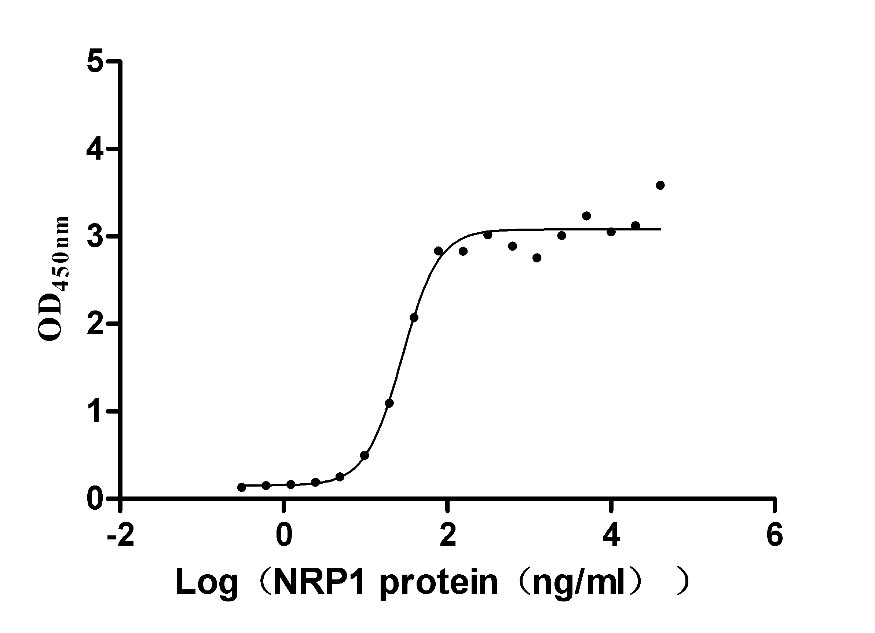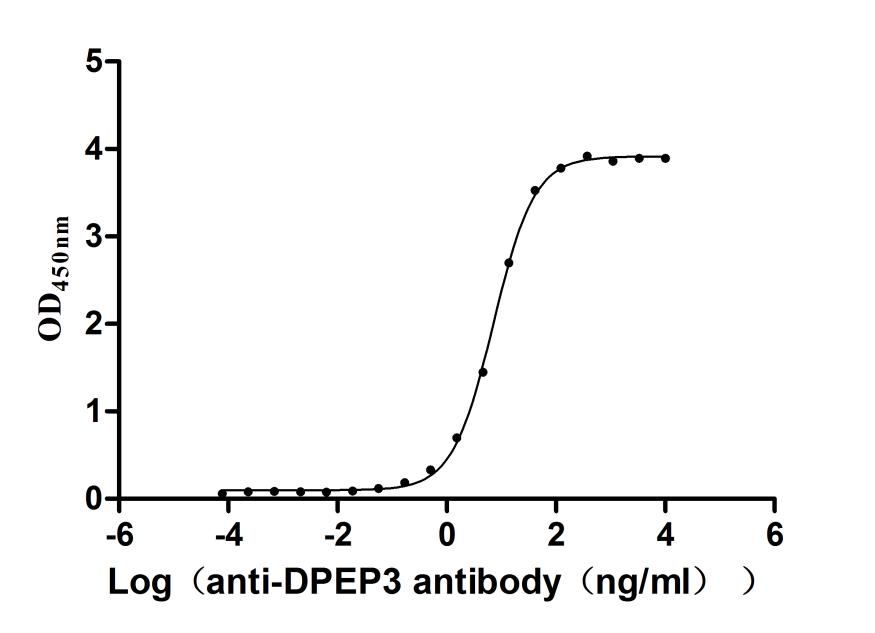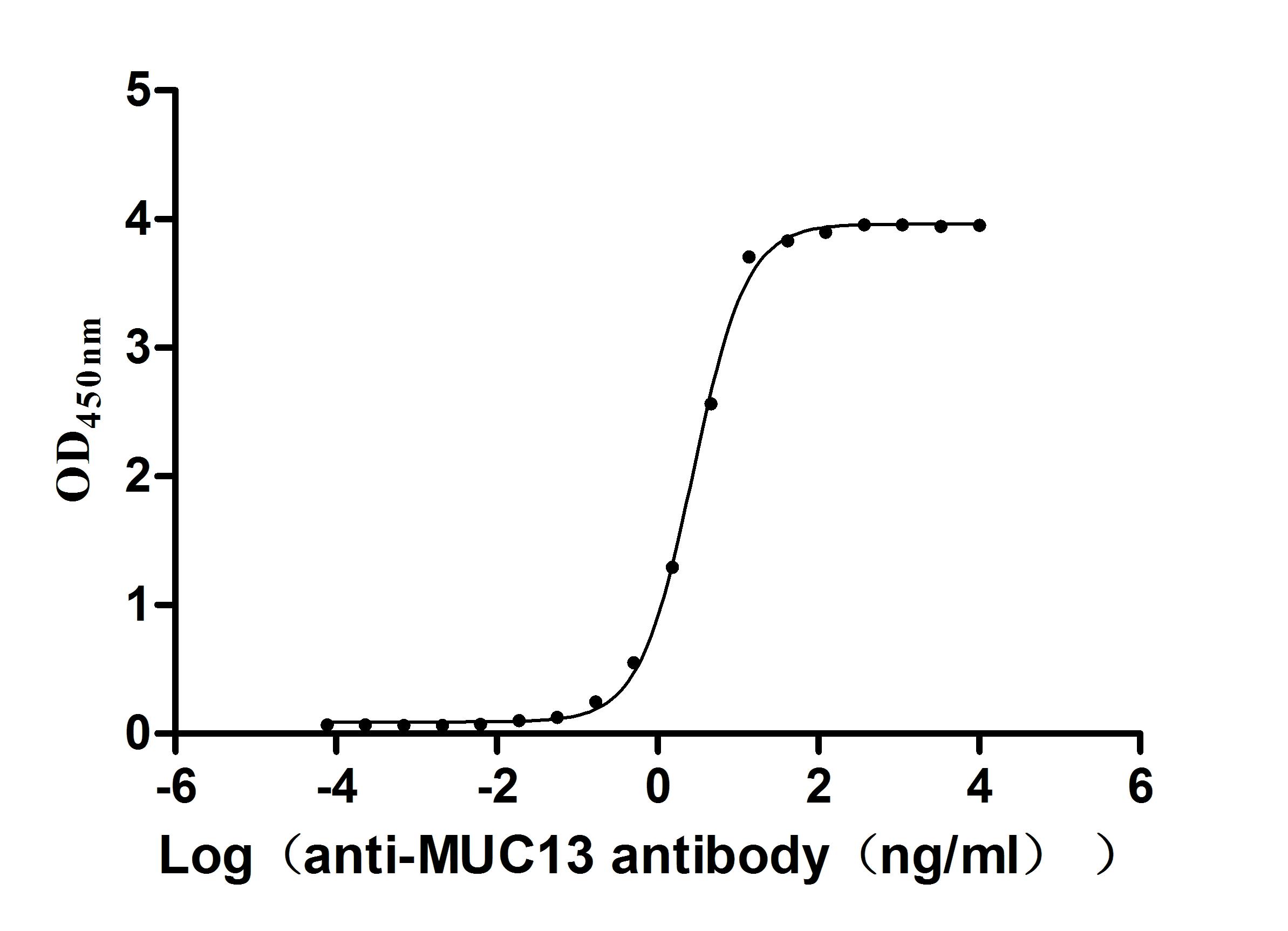Recombinant Mouse Growth/differentiation factor 8 (Mstn)
-
货号:CSB-YP015057MO
-
规格:
-
来源:Yeast
-
其他:
-
货号:CSB-EP015057MO
-
规格:
-
来源:E.coli
-
其他:
-
货号:CSB-EP015057MO-B
-
规格:
-
来源:E.coli
-
共轭:Avi-tag Biotinylated
E. coli biotin ligase (BirA) is highly specific in covalently attaching biotin to the 15 amino acid AviTag peptide. This recombinant protein was biotinylated in vivo by AviTag-BirA technology, which method is BriA catalyzes amide linkage between the biotin and the specific lysine of the AviTag.
-
其他:
-
货号:CSB-BP015057MO
-
规格:
-
来源:Baculovirus
-
其他:
-
货号:CSB-MP015057MO
-
规格:
-
来源:Mammalian cell
-
其他:
产品详情
-
纯度:>85% (SDS-PAGE)
-
基因名:
-
Uniprot No.:
-
别名:Mstn; Gdf8Growth/differentiation factor 8; GDF-8; Myostatin
-
种属:Mus musculus (Mouse)
-
蛋白长度:Full Length of Mature Protein
-
表达区域:268-376
-
氨基酸序列DFG LDCDEHSTES RCCRYPLTVD FEAFGWDWII APKRYKANYC SGECEFVFLQ KYPHTHLVHQ ANPRGSAGPC CTPTKMSPIN MLYFNGKEQI IYGKIPAMVV DRCGCS
-
蛋白标签:Tag type will be determined during the manufacturing process.
The tag type will be determined during production process. If you have specified tag type, please tell us and we will develop the specified tag preferentially. -
产品提供形式:Lyophilized powder
Note: We will preferentially ship the format that we have in stock, however, if you have any special requirement for the format, please remark your requirement when placing the order, we will prepare according to your demand. -
复溶:We recommend that this vial be briefly centrifuged prior to opening to bring the contents to the bottom. Please reconstitute protein in deionized sterile water to a concentration of 0.1-1.0 mg/mL.We recommend to add 5-50% of glycerol (final concentration) and aliquot for long-term storage at -20℃/-80℃. Our default final concentration of glycerol is 50%. Customers could use it as reference.
-
储存条件:Store at -20°C/-80°C upon receipt, aliquoting is necessary for mutiple use. Avoid repeated freeze-thaw cycles.
-
保质期:The shelf life is related to many factors, storage state, buffer ingredients, storage temperature and the stability of the protein itself.
Generally, the shelf life of liquid form is 6 months at -20°C/-80°C. The shelf life of lyophilized form is 12 months at -20°C/-80°C. -
货期:Delivery time may differ from different purchasing way or location, please kindly consult your local distributors for specific delivery time.Note: All of our proteins are default shipped with normal blue ice packs, if you request to ship with dry ice, please communicate with us in advance and extra fees will be charged.
-
注意事项:Repeated freezing and thawing is not recommended. Store working aliquots at 4°C for up to one week.
-
Datasheet :Please contact us to get it.
靶点详情
-
功能:Acts specifically as a negative regulator of skeletal muscle growth.
-
基因功能参考文献:
- the prodomain:GDF8 complex can exist in a fully latent state and an activated or "triggered" state where the prodomain remains in complex with the mature domain PMID: 29348202
- Myostatin deletion increases lean muscle mass and results in muscle-specific increases in endothelium-dependent vasodilation. PMID: 29192067
- Indoxyl sulfate enhanced the production of myostatin by enhancing oxidative stress in skeletal muscle, leading to muscle atrophy. PMID: 27549031
- Myostatin inhibition therapy for insulin-deficient type 1 diabetes has been proposed in an experimental model. PMID: 27581061
- maternal myostatin deficiency altered fetal growth and calvarial collagen content of newborn mice and conferred a lasting impact on bone geometry and biomechanical integrity of offspring at 4 mo of age. PMID: 27821779
- Mstn regulates Fndc5/Irisin expression and secretion through a novel miR-34a-dependent post-transcriptional mechanism; loss of Mstn in mice leads to the increased Fndc5/Irisin expression, which contributes to the browning of white adipocytes PMID: 27297797
- Axon diameter and myelin thickness were increased in motor axons of myostatin deficient animals. PMID: 28073155
- These data illustrate the importance of lipids as a link by which MSTN deficiency can impact mitochondrial bioenergetics in skeletal muscle. PMID: 28676454
- Myostatin inhibits eEF2K-eEF2 by regulating AMPK to suppress protein synthesis. PMID: 29024627
- These results demonstrate that a greater than additive effect is observed on the growth of skeletal muscle and in the reduction of body fat when myostatin is absent and IGF1 is in excess, and that myostatin and IGF1 regulate skeletal muscle size, myofibre type and gonadal fat through distinct mechanisms. PMID: 28533420
- Mstn deficiency but not anti-myostatin blockade induces marked proteomic changes in mouse skeletal muscle. PMID: 27214824
- GDF8 plays a significant regulatory role in bone formation and bone resorption PMID: 28074479
- Genetic inactivation of myostatin increases maximal force and power, but in return it reduces muscle quality, particularly in male mice. PMID: 27312354
- findings indicate that myostatin directly influences osteocyte function and thereby inhibits osteoblastic differentiation, at least in part, through the suppression of osteocyte-derived exosomal miR-218, suggesting a novel mechanism in muscle-bone communication. PMID: 28465350
- The 12-bp Mstn(Cmpt-dl1Abc) deletion decreases adiposity and improves whole body glucose uptake, insulin sensitivity, and (18)FDG uptake of skeletal muscle and white adipose tissue. PMID: 27965203
- In this model, increased LTBP4 led to greater muscle mass with proportionally increased strength, and decreased fibrosis. The increase in muscle mass and reduction in fibrosis were similar to what occurs when myostatin, a related TGFbeta family member and negative regulator of muscle mass, was deleted in mdx mice PMID: 27148972
- myostatin dysfunction impairs adaptation of the soleus muscle to high functional demands. PMID: 26304113
- Evidences indicate that the suppression of MSTN cause to increase the regenerative potential of injured soleus muscle via the increase in the population of muscle satellite cells regardless of unloading conditions. PMID: 27647997
- A role for Nfix in postnatal skeletal muscle development and regeneration and Myostatin gene expression regulation. PMID: 26923583
- Myostatin deletion specifically affects skeletal muscle mitochondrial function and redox status. Decreased mitochondrial function and oxidative markers persisted in aged mstn KO mice. However, muscle hypertrophy and the redox status related to this genotype appeared as beneficial side effects attenuating the age effect, as metabolic changes become less pronounced in comparison with WT mice. PMID: 26944368
- A synthetic peptide corresponding to this decorin region dose-dependently inhibited the response to myostatin in cardiomyocytes PMID: 27559042
- myostatin may play an important role in maintaining ankle and wrist joint health. PMID: 26549246
- Agouti-related peptide (AgRP) neuron activation acutely reprograms gene expression in BAT toward a myogenic signature, including increased expression of myostatin. Interference with myostatin activity improves insulin sensitivity that was impaired by AgRP neurons activation. PMID: 27015310
- Increased expression of myostatin in heart muscle cells caused interstitial fibrosis via activation of the TAK-1-MKK3/6-p38 signaling pathway PMID: 25725788
- study is the first to report an in vivo association between vitamin D, myostatin, and the regulation of muscle mass PMID: 26340892
- Report myostatin expression in early postnatal mouse masseter and rectus femoris muscles. PMID: 25982068
- An age-dependent decline in serum Gdf8 levels was identified. PMID: 26489925
- Mstn may negatively regulate Igf2 expression to control postnatal skeletal muscle growth, however differences in growth between male and female mice are not readily explained by changes in expression of Igf family members. PMID: 26198127
- the phenotypic and physiologic impact of postnatal myostatin inhibition on bite mechanics, were examined. PMID: 26252892
- Data (including data from studies in knockout mice) suggest that myostatin attenuation stimulates adipogenesis in vivo; reduced adiposity in mstn-/- knockout mice results from nutrient partitioning away from fat and in support of muscle. PMID: 26580671
- analysis of dual exon skipping of dystrophin and myostatin pre-mRNAs using phosphorodiamidate morpholino oligomers conjugated with an arginine-rich peptide PMID: 25959011
- Data show that circulating myostatin levels decreased with age and estimates of growth differentiation factor 11 (GDF11) levels using myostatin null mice indicate that they were almost 500 times lower than those for myostatin. PMID: 26372181
- MSTN haploinsufficiency protects against aging-related declines in muscle function and enhances the longevity of mice. PMID: 25808276
- results reveal that there is a novel pathway in skeletal muscle development in which miR-128 regulates myostatin at CDS region to inhibit proliferation but promote differentiation of myoblast cells. PMID: 25958325
- Myostatin modulates the expression and secretion of adipokines in fully differentiated 3T3-L1 adipocytes. PMID: 25878062
- Myostatin deficiency or antibody-mediated inhibition leads to an amelioration of arthritis severity in hTNFtg mice PMID: 26236992
- Established the myostatin mutated-mouse model in order to study myostatin, which is expressed primarily in skeletal muscle, and negatively regulates skeletal muscle mass. PMID: 25695746
- novel insights into myostatin regulation at three different mouse developmental timepoints PMID: 25695797
- FST, SMAD3, TGFBR1, and AcvR1a genes play a vital role in skeletal muscle hypertrophy in the myostatin propeptide transgenic mice. PMID: 25147795
- Myostatin/activin blocking combined with exercise reconditions skeletal muscle expression profile of mdx mice. PMID: 25304272
- Myostatin acted through the Ras-Mek-Erk signaling pathway to transcriptionally regulate miR-431 expression C2C12 cells. PMID: 25869071
- present the First low resolution solution structure of myostatin-free and myostatin-bound states of GASP-1 and GASP-2 PMID: 25657005
- The susceptibility of skeletal muscles of Mstn(-/-) mice to atrophy during hindlimb suspension is due to an up- and downregulation, respectively, of the mechanisms regulating atrophy of myofibres and translation of mRNA. PMID: 24718581
- Gasp-1 overexpression resulted in increased myostatin expression. PMID: 25277978
- Cardiac MTSN activation occurs rapidly after cardiac ischemia. PMID: 25528587
- reduced sarcoplasmic reticulum calcium release underlies the reduced muscle force in mutant Cmpt animals PMID: 24445322
- our results reveal an essential role for myostatin in the pathogenesis of cancer cachexia and link this condition to tumor growth, with implications for furthering understanding of cancer as a systemic disease. PMID: 25336187
- role of myostatin in cardiovascular disease and cachexia PMID: 24680839
- MyoD expression was detected to identify impact of IGF-1 on myoblasts differentiation when exposed to myostatin. PMID: 24575400
- mechanical vibration strongly down-regulates atrophy genes myostatin and atrogin-1 both in vivo and in vitro. PMID: 22711460
显示更多
收起更多
-
亚细胞定位:Secreted.
-
蛋白家族:TGF-beta family
-
组织特异性:Expressed specifically in developing and adult skeletal muscle. Weak expression in adipose tissue.
-
数据库链接:
KEGG: mmu:17700
STRING: 10090.ENSMUSP00000027269
UniGene: Mm.3514
Most popular with customers
-
Recombinant Human Neuropilin-1 (NRP1) (Active)
Express system: Mammalian cell
Species: Homo sapiens (Human)
-
Recombinant Macaca fascicularis lymphocyte antigen 6 family member G6D (LY6G6D) (Active)
Express system: Yeast
Species: Macaca fascicularis (Crab-eating macaque) (Cynomolgus monkey)
-
Recombinant Human Oncostatin-M (OSM), partial (Active)
Express system: Mammalian cell
Species: Homo sapiens (Human)
-
Recombinant Human Myosin regulatory light chain 12A (MYL12A) (Active)
Express system: E.coli
Species: Homo sapiens (Human)
-
Recombinant Human Dipeptidase 3(DPEP3), partial (Active)
Express system: Mammalian cell
Species: Homo sapiens (Human)
-
Recombinant Human Mucin-13(MUC13),partial (Active)
Express system: yeast
Species: Homo sapiens (Human)


















